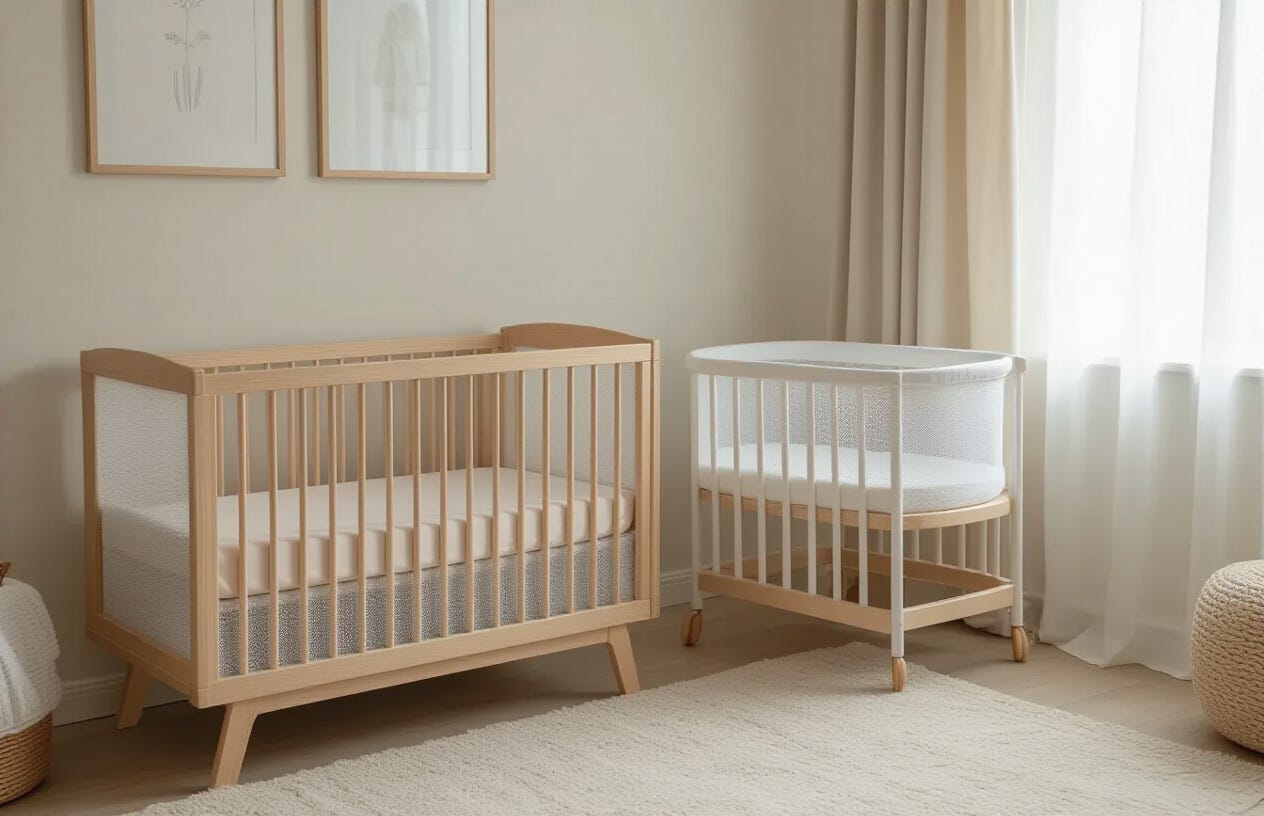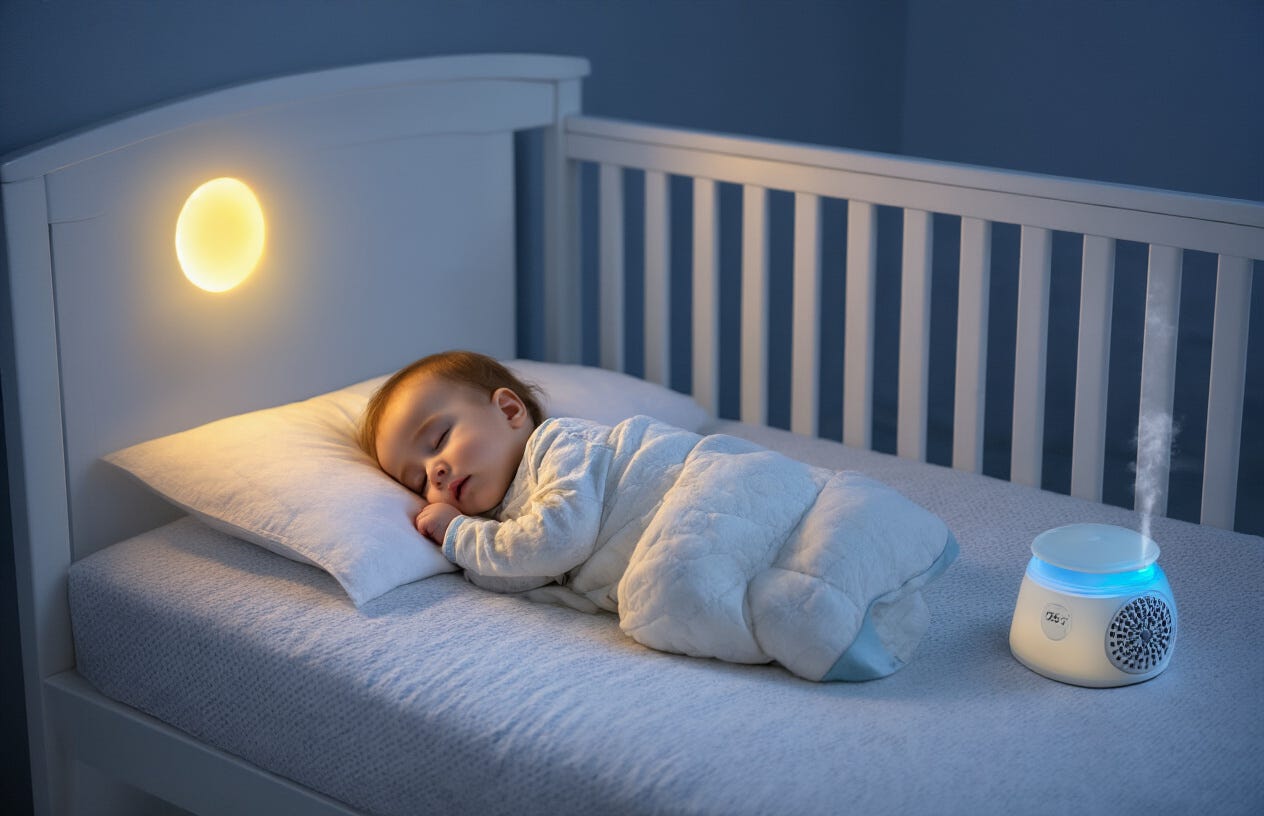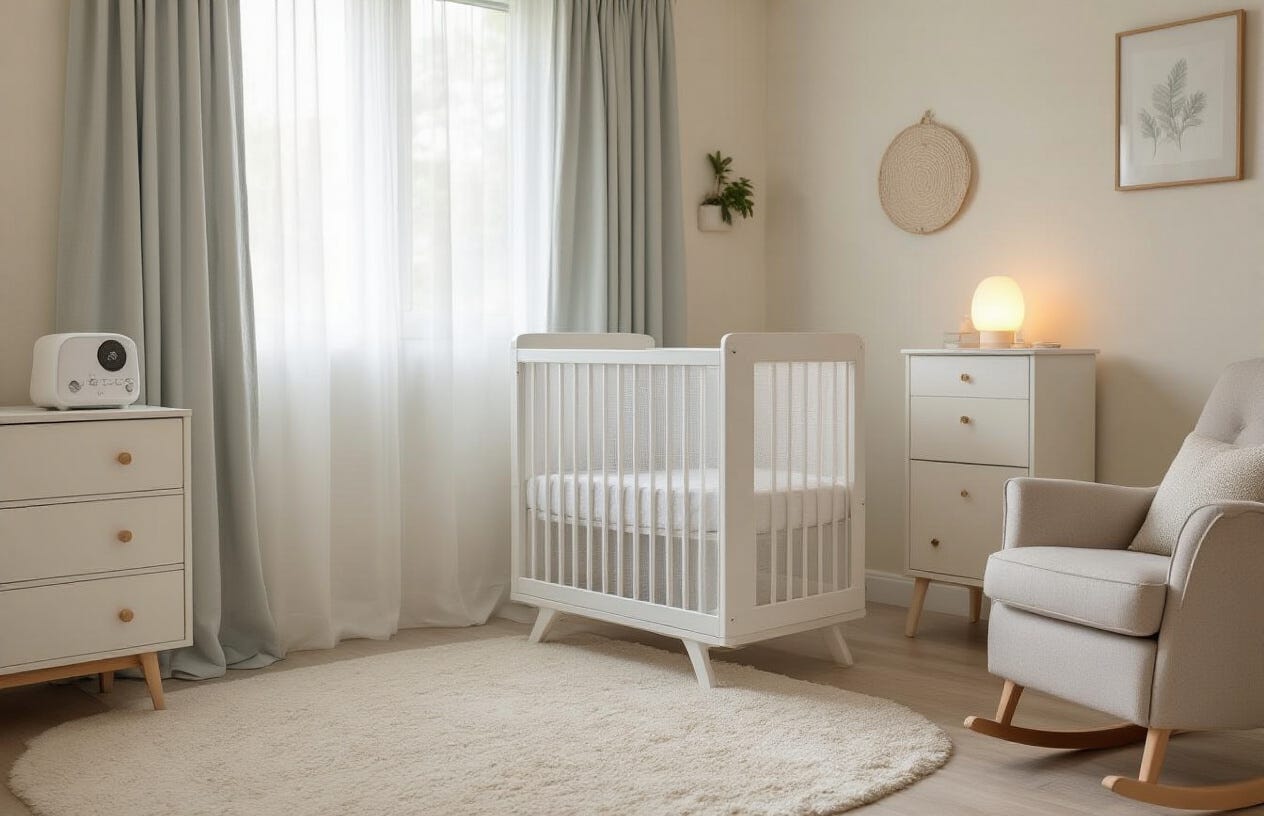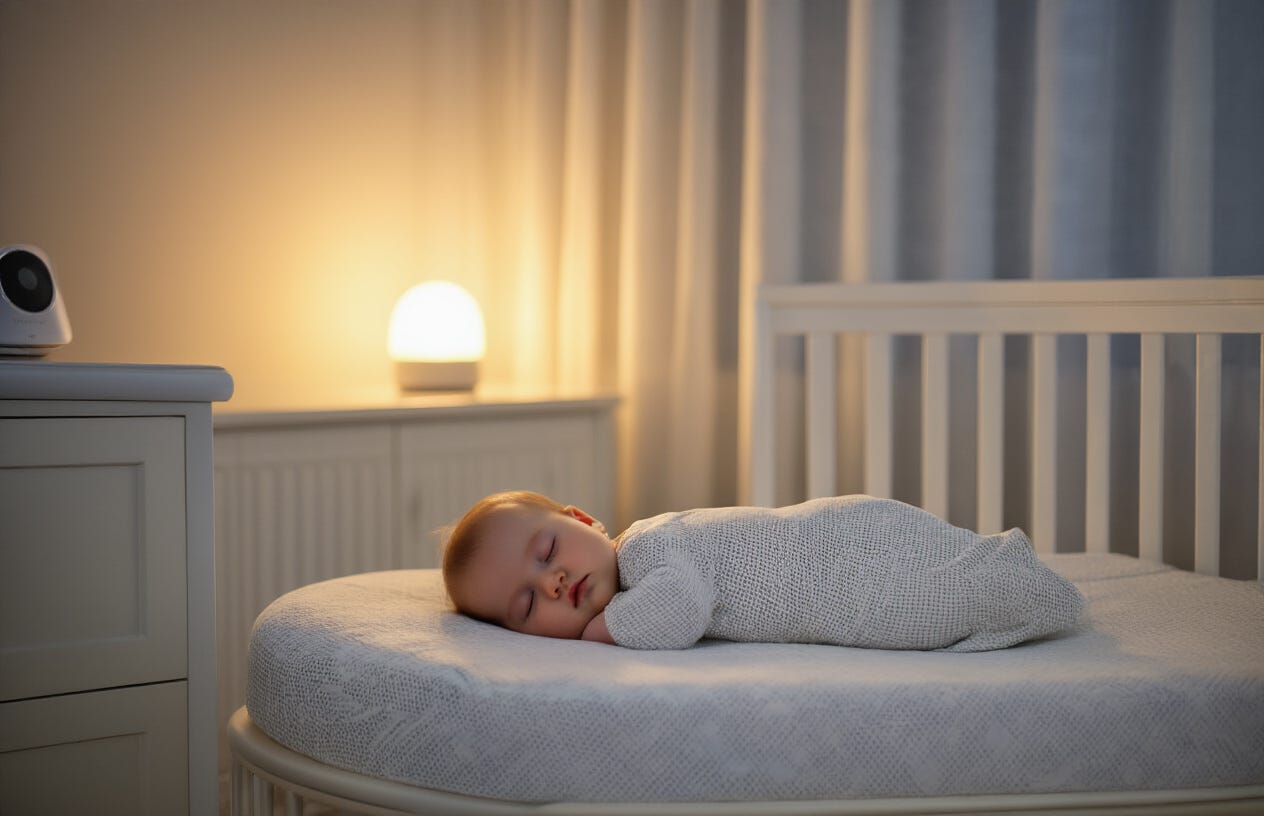Creating a Safe and Soothing Sleep Environment for Your Baby
Ever wondered what keeps 40% of new parents up at night? It’s not just their baby’s cries—it’s the endless worry about whether their little one’s sleep space is actually safe.
I get it. The avalanche of advice is overwhelming. Your mother-in-law has opinions. That Facebook group has contradicting “rules.” And the baby store employee suggested you need seventeen different sleep products.
Creating a safe and soothing sleep environment for your baby doesn’t have to be complicated. By the end of this post, you’ll have a clear roadmap for setting up a space where your baby can sleep soundly—and you can finally stop googling “is this normal?” at 3am.
What most parenting books won’t tell you about baby sleep environments is something so fundamental it might surprise you…
Understanding Infant Sleep Safety Standards

Current AAP Guidelines for Safe Sleep
The American Academy of Paediatrics doesn’t mess around when it comes to baby sleep safety. Their most recent guidelines are crystal clear: babies should sleep on their backs on a firm, flat surface with nothing else in the crib. No pillows. No blankets. No stuffed animals. Just your baby in a sleep sack or wearable blanket.
Parents often ask me, “But what if my baby rolls over?” Once your little one can roll both ways on their own, you don’t need to flip them back. Their muscles are developed enough to adjust their position if needed.
Room-sharing (not bed-sharing) is recommended for at least the first six months, ideally the first year. Having your baby sleep in your room cuts SIDS risk by up to 50%. That’s huge.
SIDS Prevention Measures
SIDS is every parent’s nightmare, but you can dramatically reduce the risk by:
- Keeping the room cool (68-72°F)
- Using a fan to improve air circulation
- Offering a pacifier at sleep time
- Never smoking around your baby
- Breastfeeding if possible
The pacifier tip surprises many parents, but studies show it can reduce SIDS risk by 50-90%. You don’t need to reinsert it if it falls out during sleep.
Baby Sleep Safety Checklist
✓ Firm crib mattress that fits snugly
✓ Fitted sheet only
✓ Baby placed on back
✓ Nothing in crib (no toys, pillows, bumpers)
✓ Room temperature 68-72°F
✓ Baby dressed appropriately (not overheated)
✓ Crib away from windows, cords, and heaters
✓ Baby monitor secured away from crib
✓ Smoke detectors working properly
Common Safety Hazards to Avoid
The nursery is full of sneaky hazards that exhausted parents might miss. Crib bumpers? They’re cute but dangerous. Drop-side cribs? Banned for safety reasons. Inclined sleepers? Linked to infant deaths.
Baby nests and loungers aren’t safe for sleep either, no matter how cozy they look on Instagram. Your newborn doesn’t care about aesthetics—they want safety.
And please, check those crib slats! They should be no more than 2⅜ inches apart (about the width of a soda can). Older cribs might not meet current safety standards, so measure before using hand-me-downs.
Choosing the Ideal Crib or Bassinet

A. Safety Certifications to Look For
When shopping for your baby’s crib, don’t just go for what looks cute. Those safety certifications? They’re non-negotiable.
Look for the JPMA (Juvenile Products Manufacturers Association) seal on cribs and bassinets. This means the product meets or exceeds safety standards set by ASTM International.
Also check that the crib complies with CPSC (Consumer Product Safety Commission) regulations. After 2011, all cribs sold in the US must meet these updated standards – no drop sides allowed, stronger mattress supports, and more durable hardware.
B. Mattress Firmness and Fit
Your baby’s mattress should be firm – really firm. If it feels comfy to you, it’s probably too soft for your baby.
The mattress should fit snugly against the crib frame. Try the two-finger test: if you can fit more than two fingers between the mattress and the crib frame, it’s too small and creates a dangerous gap where your baby could get trapped.
C. Proper Crib Placement in the Nursery
Keep that crib away from windows, blinds, cords, and hanging mobiles. Seriously. Babies are surprisingly strong and curious.
Position the crib against a wall that doesn’t share plumbing or electrical outlets if possible. And never place it near a heater or air conditioner vent.
Make sure you’ve got enough room to easily access your baby from at least one side of the crib.
D. When to Transition from Bassinet to Crib
Most babies outgrow bassinets around 3-4 months or when they start pushing up on their hands and knees – whichever comes first.
Watch for these signs:
- Your baby looks cramped
- They’re hitting the sides
- They’ve reached the weight limit (usually 15-20 pounds)
- They’re starting to roll over
Don’t wait until your baby has completely outgrown the bassinet. Start the transition a little earlier to give them time to adjust.
E. Second-hand Equipment Safety Considerations
Hand-me-downs can be great, but not all baby gear ages well.
Never use a crib made before 2011 – those older models often have dangerous drop-sides or wider slat spacing.
Check for:
- Missing hardware or loose parts
- Cracks or splinters
- Lead paint (for cribs made before 1978)
- Recall history (search the CPSC website)
Always get a new mattress even if the crib is used. Old mattresses can harbor mold and bacteria, plus they lose firmness over time.
Creating the Optimal Sleep Temperature

Ideal Room Temperature for Infant Sleep
Ever noticed how babies sleep like angels when the temperature’s just right? That’s not a coincidence. Babies can’t regulate their body temperature like we can, so getting the room temp perfect is crucial.
The sweet spot? Between 68-72°F (20-22°C). Too hot increases SIDS risk, while too cold makes for a cranky, restless baby.
Don’t have a thermometer handy? Here’s a quick trick: if you’re comfortable in light clothing, your baby probably is too. Still unsure? Touch the back of your baby’s neck—not hands or feet (they’re always cooler). If it’s sweaty, they’re too warm. If it feels cool to touch, add another layer.
Appropriate Sleepwear Based on Season
Summer nights call for different jammies than winter evenings. Makes sense, right?
Summer sleepwear:
- Single layer cotton onesie or lightweight sleep sack
- Skip the hat—babies release heat through their heads
- For AC rooms, maybe add a light cotton swaddle
Winter sleepwear:
- Layer it up! Onesie under footed pajamas works great
- Wearable blankets/sleep sacks rated for colder temps
- Remember: better slightly cool than overheated
Safe Swaddling Techniques
Swaddling mimics that snug womb feeling babies love, but there’s a right way to do it:
- Use a lightweight, breathable blanket
- Place baby centred on the blanket, shoulders at the top edge
- Fold one side over baby’s body and tuck under their opposite arm
- Bring bottom corner up toward shoulders
- Fold remaining side over and tuck underneath
Stop swaddling once baby shows signs of rolling over (usually around 3-4 months). After that, transition to a sleep sack to maintain that cozy feeling without the rollover risk.
Signs Your Baby is Too Hot or Cold
Babies can’t tell you “Hey, I’m freezing!” so watch for these clues:
Too hot:
- Flushed, red face
- Damp hair or sweaty back of neck
- Rapid breathing
- Heat rash
- Restlessness
Too cold:
- Cold tummy or back (not hands/feet—they’re naturally cooler)
- Pale or blotchy skin
- Seems extra sleepy or lethargic
Trust your instincts! If something seems off with baby’s temperature, it probably is. A quick clothing adjustment is usually all it takes to get back to peaceful slumber.
Lighting and Sound Management

Benefits of Blackout Curtains
Ever tried putting a baby to sleep in a room with light streaming in? Yeah, good luck with that. Blackout curtains are absolute game-changers for baby sleep. They block out 99% of outside light, creating that cave-like darkness babies crave for deep sleep.
Babies haven’t yet developed the ability to ignore environmental stimuli like light. Their brains basically think: “Light means playtime!” Even streetlights or early morning sun can trigger their wake response.
The magic of blackout curtains extends to nap time too. No more “45-minute intruder” where baby wakes up after one sleep cycle. In a pitch-black room, they’re more likely to connect those cycles and give you the holy grail of baby parenting: longer naps.
Nightlight Options and Placement
A strategic nightlight makes midnight feedings and diaper changes way less disruptive. The key word here is “strategic.”
Red or amber lights are your best friends. Unlike blue or white light, they don’t suppress melatonin (the sleep hormone). Place them away from baby’s direct line of sight but close enough to help you see what you’re doing.
Some smart options to consider:
Nightlight Type Best Feature Placement Tip Salt lamps Natural amber glow Corner dresser Motion-activated strips Only on when needed Under crib or changing table Dimmable globe Adjustable brightness Shelf opposite crib
White Noise Machines and Their Proper Use
White noise isn’t just a sleep hack—it’s mimicking what babies heard in the womb. That constant whooshing sound creates a familiar environment that drowns out household noises that might jolt them awake.
But not all white noise is created equal. You want pure, continuous sound—not ocean waves or heartbeats that change rhythm. Place the machine at least 6 feet from the crib and keep the volume lower than you think (around 50 decibels, or the sound of a quiet shower).
Don’t turn it off the moment baby falls asleep. Let it run through the entire nap or night sleep to mask those inevitable household sounds—like when you finally get to eat chips after they’re asleep.
Creating Day/Night Distinction for Better Sleep Cycles
Babies aren’t born knowing day from night. Their circadian rhythms are completely undeveloped, which explains those party-all-night newborn phases.
During daytime naps, keep some natural light in the room. Use regular curtains instead of blackouts, or leave the door slightly cracked. Normal household noise is fine—even good—during day sleep.
For nighttime, flip the script completely. Blackout curtains closed, white noise on, interactions minimal. When you do those middle-of-the-night feedings or changes, keep lights dim and conversation nonexistent.
This consistent contrast helps their developing brain learn when it’s time for short naps versus long overnight sleep. Within a few weeks, you’ll start seeing their sleep patterns align more with your (desperately desired) schedule.
Designing a Calming Nursery Environment

Soothing Color Schemes for Better Sleep
Ever noticed how certain colors make you feel instantly calm? The same goes for your baby.
Soft, muted tones work wonders in a nursery. Pale blues, gentle lavenders, and soft greens tell your baby’s brain “it’s time to relax.” Avoid bright reds, oranges, or bold patterns that might overstimulate when you’re desperately trying to get them down for the night.
Paint isn’t your only color consideration. Think about your crib sheets, curtains, and even the lampshade. Everything contributes to the vibe.
Not ready to repaint? No problem. Add calming colors through:
- Removable wall decals
- Soft throw blankets (stored away from the crib)
- Area rugs in soothing shades
Minimizing Distractions and Stimulation
Babies notice everything. That dancing mobile that seems so cute? It might be keeping them wide-eyed at 2 AM.
Remove anything visually busy from areas where your baby sleeps. This includes:
- Flashing lights from electronics
- Busy patterns on walls
- Toys with lights or sounds
Consider blackout curtains – they’re absolute game-changers. They block street lights and early morning sunshine that can wake your little one prematurely.
Keep noisy household items (like the washing machine) far from the nursery if possible. And think about a white noise machine to mask sudden sounds that might startle your baby awake.
Organizing the Room for Midnight Care
Nothing’s worse than stumbling around in the dark looking for diapers during a 3 AM change.
Set up strategic stations around the room:
- Changing area with easy-to-grab diapers, wipes, and cream
- Feeding corner with a comfortable chair, burp cloths, and water for you
- Clean clothes within arm’s reach of the changing table
Consider installing dimmer switches or using a small night light. You need just enough light to see what you’re doing without signaling to your baby it’s playtime.
Keep a small trash can nearby for used diapers – trust me, you don’t want to be walking across the room multiple times during night changes.
Baby-friendly Air Quality Solutions
The air your baby breathes while sleeping matters more than you might think.
Keep the nursery between 68-72°F (20-22°C) – the sweet spot for baby sleep. Too hot actually increases SIDS risk, while too cold might wake them.
Humidity levels matter too. Aim for 40-60% humidity – not too dry, not too damp. A good humidifier can help, especially during winter months when heating systems dry out the air.
Regular dusting and vacuuming with a HEPA filter vacuum helps keep allergens at bay. And skip the heavily scented products – babies don’t need fancy air fresheners or scented candles. Their little respiratory systems prefer clean, simple air.
Adding Comforting Elements Without Compromising Safety
We all want cozy nurseries, but safety comes first.
Safe comfort additions include:
- Sound machines that play gentle white noise or womb sounds
- Soft lighting that doesn’t shine directly on the crib
- Blackout curtains secured well away from the crib
What to avoid:
- Crib bumpers (even the “breathable” ones)
- Pillows, blankets, or stuffed animals in the sleep space
- Hanging decor that could fall
You can create warmth through textured wall hangings placed securely away from the crib or through a soft rug under your feet for those midnight visits.
Remember, the safest sleep environment is also the simplest: just your baby on a firm mattress with a fitted sheet in appropriate sleepwear. Everything else stays outside the sleep space until they’re older.

The journey to creating the perfect sleep environment for your baby combines both safety and comfort considerations. From adhering to the latest infant sleep safety standards to selecting an appropriate crib or bassinet, every element plays a vital role in your little one’s sleep quality. Maintaining optimal room temperature, managing lighting and sound levels, and designing a calming nursery all work together to create a space where your baby can rest peacefully.
Remember that each baby is unique, and you may need to make adjustments to find what works best for your little one. By prioritising safety while creating a soothing atmosphere, you’re not just helping your baby sleep better—you’re providing them with a secure foundation for healthy development. Sweet dreams start with a thoughtfully designed sleep environment that grows with your child through their early years.